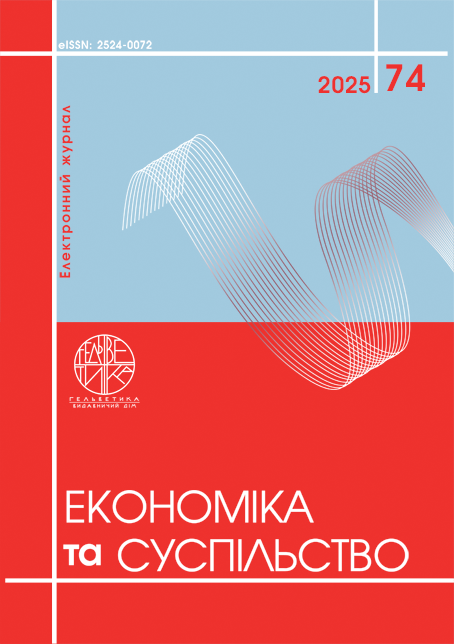STRUCTURE AND ELEMENTS OF THE INNOVATION ACTIVITY MECHANISM IN ENTERPRISES
Abstract
This article addresses key aspects of understanding the structure of innovation activity mechanisms within food industry enterprises. The study's relevance is driven by the need to establish a conceptual and methodological foundation for interpreting innovation mechanisms as integral parts of business operations. The research methodology combines literature analysis, regulatory document review, statistical data examination, and synthesis of practical experience from domestic and international enterprises in the food sector. The study systematically identifies and evaluates how enterprises perceive and implement innovation mechanisms. It distinguishes innovation as a technical or creative process and a structured system supported by management frameworks, project management tools, and enterprise-wide involvement. Key findings highlight the necessity of viewing innovation as a dynamic system that requires active engagement from various levels of the organization. The research also illustrates the potential benefits of project-based approaches in structuring innovation activities, as they offer clarity, scalability, and focus on deliverables. These insights help clarify the link between innovation strategies and business performance. The study emphasizes that innovation should be viewed as a dynamic and continuous process involving various stakeholders and organizational levels. It is not limited to technological improvements but includes organizational, managerial, and procedural transformations. The article illustrates the potential of project management methodologies to enhance innovation initiatives' clarity, scalability, and goal orientation. Project-based innovation structures enable better resource allocation, risk management, and outcome measurement. The practical value of this study lies in the development of a structured innovation mechanism model tailored to the specific needs of food industry enterprises. This model can serve as a practical guide for enterprise managers, consultants, and policymakers aiming to improve innovation planning, coordination, and execution. Furthermore, it supports the creation of a more innovation-friendly business environment through better alignment of strategic objectives and operational capabilities.
References
Словник української мови: в 11 тт. / АН УРСР. Інститут мовознавства; за ред. І. К. Білодіда. — К.: Наукова думка, 1970—1980.
Інноваційний розвиток підприємства. Підручник / за заг. ред. д-ра екон. наук, проф. Микитюка П. П. Тернопіль: ЗУНУ, 2023. 320 с.
Мороз О. С. Інноваційний розвиток підприємства: сутність та проблема визначення складових частин/ О. С. Мороз // Наукові записки [Національного університету "Острозька академія"]. Сер..: Економіка. - 2012. - Вип. 20. - С.148-150 URL: http://nbuv.gov.ua/UJRN/Nznuoa_2012_20_33 (дата звернення: 11.05.2025)
Li, R., Rao, J., & Wan, L. (2022). The digital economy, enterprise digital transformation, and enterprise innovation. Managerial and Decision Economics, 43(7), 2875–2886.
OECD/Eurostat. (2018). Oslo manual 2018: Guidelines for collecting, reporting and using data on innovation (4th ed.). OECD. https://doi.org/10.1787/9789264304604-en (дата звернення: 11.05.2025)
Project Management Institute. (2017). A guide to the project management body of knowledge (PMBOK guide) (6th ed.). Project Management Institute.
Schumpeter, J. A. (1934). The theory of economic development: An inquiry into profits, capital, credits, interest, and the business cycle. Transaction Publishers.
Shestakov, D. Y. (2018). Understanding innovation: process, project and product-centric views. Efektyvna ekonomika, vol. 12. https://doi.org/10.32702/2307-2105-2018.12.209 (дата звернення: 11.05.2025)
Bilodid, I. K. (Red.). (1970–1980). Slovnyk ukrainskoi movy (v 11 tt.) [Dictionary of the Ukrainian language (in 11 vols.)]. AN URSR, Instytut movoznavstva. Naukova dumka. (in Ukrainian)
Innovatsiinyi rozvytok pidpryiemstva: Pidruchnyk / za zah. red. d-ra ekon. nauk, prof. Mykytiuka P. P. (2023). Ternopil: Zakhidnoukrainskyi natsionalnyi universytet. [Innovative development of the enterprise: Textbook]. (in Ukrainian)
Moroz, O. S. (2012). Innovatsiinyi rozvytok pidpryiemstva: sutnist ta problema vyznachennia skladovykh chastyn [Innovative development of the enterprise: essence and the problem of defining its components]. Naukovi zapysky Natsionalnoho universytetu “Ostrozka akademiia”. Seriia: Ekonomika, 20, 148–150. http://nbuv.gov.ua/UJRN/Nznuoa_2012_20_33 (in Ukrainian) (accessed May 11, 2025)
Li, R., Rao, J., & Wan, L. (2022). The digital economy, enterprise digital transformation, and enterprise innovation. Managerial and Decision Economics, 43(7), 2875–2886.
OECD/Eurostat. (2018). Oslo manual 2018: Guidelines for collecting, reporting and using data on innovation (4th ed.). OECD. https://doi.org/10.1787/9789264304604-en (accessed May 11, 2025)
Project Management Institute. (2017). A guide to the project management body of knowledge (PMBOK guide) (6th ed.). Project Management Institute.
Schumpeter, J. A. (1934). The theory of economic development: An inquiry into profits, capital, credits, interest, and the business cycle. Transaction Publishers.
Shestakov, D. Y. (2018). Understanding innovation: Process, project and product-centric views. Efektyvna ekonomika, 12. https://doi.org/10.32702/2307-2105-2018.12.209 (accessed May 11, 2025)

This work is licensed under a Creative Commons Attribution 4.0 International License.


